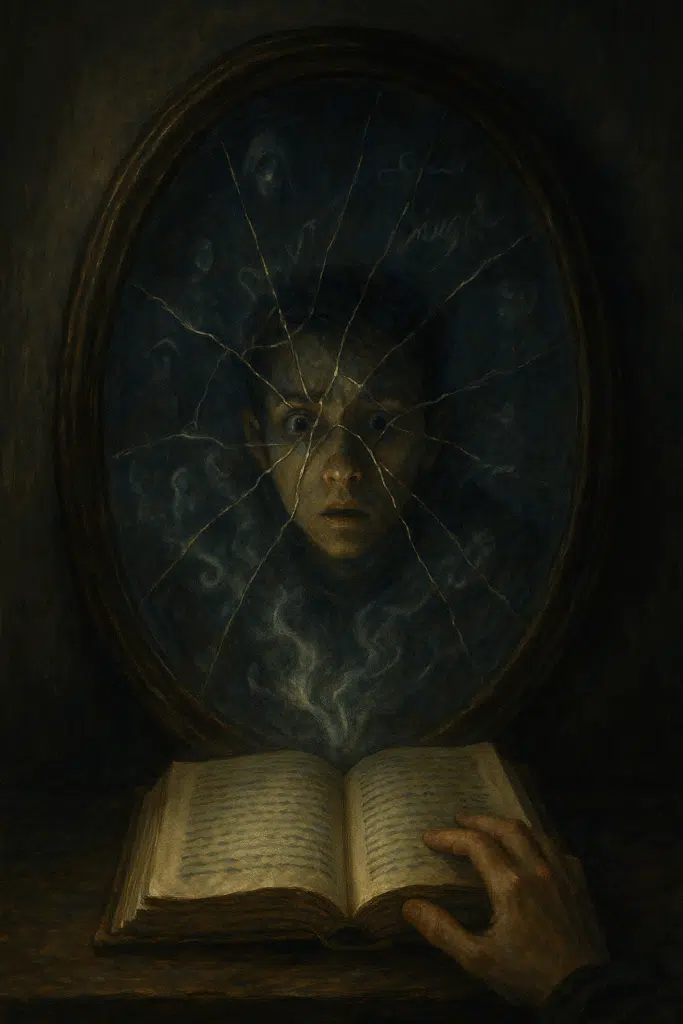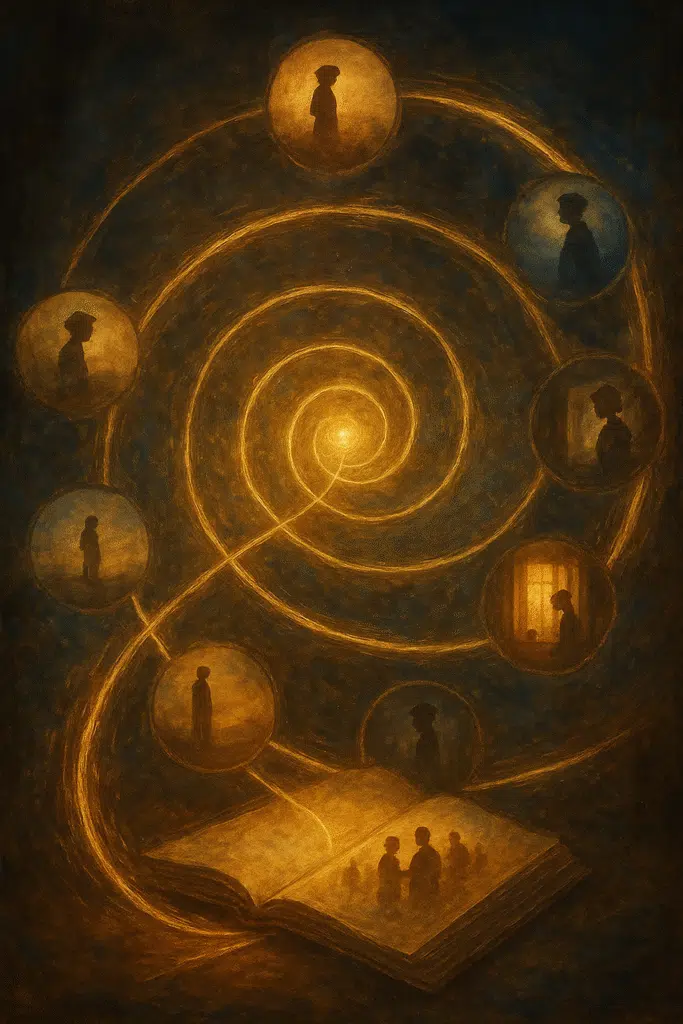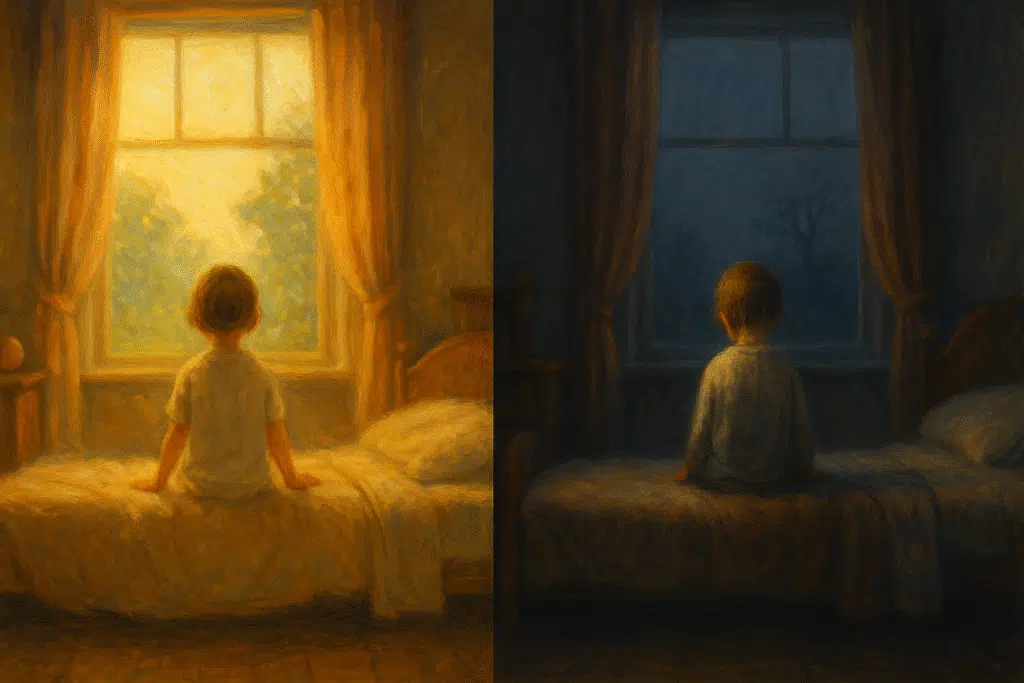Estimated Reading Time: 27 minutes (5126 words)
The most powerful stories aren’t just told—they’re architected. Behind every narrative that lingers in your mind long after the final page, there’s a deliberate manipulation of story mechanics working quietly beneath the surface. These aren’t just technical flourishes; they’re the invisible hands that guide your emotions, challenge your expectations, and transform what could be ordinary storytelling into something that resonates in your bones.
Writers often fixate on perfecting character arcs and following tried-and-true plot structures, yet miss how the mechanical elements—strategic discomfort, unexpected rhythm shifts, and calculated information control—create the difference between stories that merely entertain and those that transform. The truly memorable moments in literature and film aren’t just well-written scenes; they’re mechanical triumphs where form and content merge to create something greater than either could achieve alone.
This isn’t about following formulas or studying narrative blueprints. It’s about understanding how the deliberate arrangement of story elements creates meaning beyond what words alone can convey. When a writer makes you uncomfortable at precisely the right moment, when familiar story beats suddenly shift beneath your feet, or when something you thought you understood appears in an entirely new context—that’s when mechanics transcend technique and become art.
The gap between good stories and unforgettable ones often lies not in what happens, but in how it’s constructed to happen. And that’s where we begin our exploration of how story mechanics don’t just support meaning—they create it.
Storytelling isn’t just about what you say, but how you arrange and deliver it. While many writers focus solely on plot structures and character arcs, it’s often the mechanical elements—the deliberate discomforts, unexpected pacing shifts, and recontextualization of familiar elements—that elevate a story from formulaic to unforgettable.
- Create purposeful discomfort, not frustration: Strategic tension and unease can deepen reader engagement when it serves the story. The moments that make readers slightly uncomfortable often become the ones they remember most vividly.
- Break patterns to heighten awareness: When you establish a narrative rhythm and then deliberately disrupt it, you command attention. This mechanical shift forces readers to engage more actively with what comes next.
- Balance description density with pacing needs: Heavy description creates stillness; sparse details accelerate momentum. Neither approach is inherently better—the artistry lies in knowing when each serves your story’s emotional beats.
- Transform mechanics into meaning: Story structures aren’t just organizational tools but thematic vessels. When your story’s form mirrors its message, readers experience your themes rather than just reading about them.
- Recontextualize the familiar to create depth: Introducing a familiar element, then revealing it in a new light later forces readers to reconsider earlier scenes. This mechanical reframing creates layered stories that reward rereading.
- Control information flow strategically: Every revelation should arrive at precisely the right moment—not when it’s convenient for the plot, but when it creates the most significant impact for the reader.
- Leverage structural echoes deliberately: Recurring motifs, parallel scenes, and bookended moments aren’t just artistic flourishes—they’re mechanical tools that create emotional resonance through pattern recognition.
Great storytelling happens when mechanics and meaning work in harmony. In the sections that follow, we’ll explore how to move beyond formulaic approaches to craft narratives where every structural choice serves a deeper purpose.

The Mechanics Behind Memorable Stories
Why some narratives linger while others fade
Stories that truly haunt us—the ones we carry for years after experiencing them—achieve this lasting power not merely through compelling plots or interesting characters, but through the invisible architecture supporting them. While compelling characters form the foundation of memorable narratives, the mechanical choices in how we reveal and develop those characters often determine whether they linger in readers’ minds or fade into forgettability. This underlying framework operates much like musical composition, where the notes themselves matter less than their arrangement, timing, and relationship to silence.
Consider how certain narratives manage to occupy mental real estate long after their consumption. The staying power of works like Shirley Jackson’s “The Lottery” or films like “The Sixth Sense” transcends their surface elements. Yes, they feature shocking twists, but countless stories with surprising endings vanish from memory within days. What distinguishes the unforgettable is how their mechanical elements—pacing decisions, information release strategies, structural choices—align to create an experience that feels both inevitable and impossible to shake.
Memorable narratives often employ what might be called “cognitive hooks”—structural elements that force the mind to continuously process and reprocess the experience. When Kazuo Ishiguro’s “Never Let Me Go” gradually reveals its premise, the revelation isn’t simply delivered as information but emerges through a carefully constructed fog of half-understandings that mirrors the characters’ own dawning comprehension. This mechanical choice creates a parallel experience for the reader that mere exposition never could.
Stories fade when their mechanics serve only functional purposes—moving characters from point A to B, establishing basic facts, or delivering expected emotional beats. They linger when these same mechanics are charged with additional meaning, when the how of storytelling becomes inseparable from the what.

When Discomfort Becomes Powerful
The crucial difference between frustrating and challenging readers
Discomfort in storytelling represents a delicate balance—push readers too far without purpose and they abandon the journey; fail to push them at all and they remain unmoved. The distinction lies in intent and execution. Frustration emerges when mechanical challenges feel arbitrary or manipulative—when plot points strain credulity, when information is withheld solely to manufacture suspense, or when emotional payoffs feel unearned.
Purposeful discomfort, by contrast, serves the story’s deeper aims. When Cormac McCarthy strips away punctuation and conventional dialogue formatting in “The Road,” the mechanical choice creates a reading experience that mirrors the stark, lawless world he depicts. This principle of purposeful discomfort extends beyond traditional storytelling into collaborative narrative forms, where creating safe spaces for creative risk-taking paradoxically enables the most powerful and vulnerable performances. The disorientation readers feel navigating his prose echoes the protagonists’ journey through a devastated landscape. The discomfort isn’t an obstacle to understanding—it is the understanding.
Writers who effectively deploy discomfort understand that readers don’t primarily seek comfort—they seek meaning. They will tolerate, even embrace difficulty when it feels essential to the story’s truth. George Saunders’ “Lincoln in the Bardo” demands significant work from readers with its experimental structure and chorus of voices, yet this mechanical challenge directly serves its exploration of grief and historical memory. The form doesn’t obstruct the content; it becomes the content.
Moments of purposeful unease that readers never forget
The moments of discomfort that readers carry longest often come when mechanical elements conspire to create an uncanny sense of rightness within wrongness. In “The Handmaid’s Tale,” Margaret Atwood’s abrupt shifts between present action and memory create a dislocated reading experience that embodies her protagonist’s fractured reality. The mechanical choice doesn’t simply illustrate her psychological state—it reproduces it in the reader’s own cognitive experience.
Film provides even more visceral examples. When Christopher Nolan employs competing timelines in “Dunkirk” that eventually converge, the resulting temporal disorientation mirrors the chaotic experience of war itself. The audience’s struggle to orient themselves within the narrative structure becomes an essential part of understanding the subject matter.
These moments succeed because they arise from necessity rather than novelty. The mechanical choice—whether it’s unreliable narration, disorienting structure, or withholding crucial context—emerges organically from what the story demands. The discomfort serves as a bridge between intellectual understanding and embodied experience.

The Art of Pattern Disruption
Establishing rhythms readers subconsciously follow
Humans are pattern-recognition machines. We instinctively search for and lock onto rhythms in everything we encounter, including narrative. Skilled storytellers exploit this tendency by establishing patterns that readers unconsciously internalize—regular chapter lengths, consistent narrative viewpoints, reliable tonal shifts, predictable scene structures. These patterns create a sense of order that allows readers to engage with content without constantly monitoring form.
Consider how detective fiction traditionally establishes rhythmic movement between investigation scenes and personal moments, or how epic fantasy often creates a pulsing cadence between action and worldbuilding. These patterns aren’t merely organizational—they form a subliminal contract with readers, training expectations about how the story will unfold. Writers like Haruki Murakami establish hypnotic, dreamlike rhythms that lull readers into accepting increasingly surreal developments.
The remarkable power of pattern establishment lies in how quickly readers adapt to even unconventional structures. David Mitchell’s “Cloud Atlas” nests six distinct stories using completely different styles, yet within each section, readers quickly attune to its particular rhythm. This capacity for pattern recognition creates the foundation for the most powerful mechanical tool at a writer’s disposal: meaningful disruption.
Breaking cadence at pivotal moments
When established patterns suddenly shift, readers snap to attention. This heightened awareness creates the perfect conditions for delivering crucial story moments. The disruption itself becomes a signal that something significant is occurring—not just in what is being told, but in how it’s being told.
Alice Munro masterfully employs this technique in her short stories, establishing methodical pacing before delivering life-altering revelations in disarmingly direct, unadorned sentences that break the established cadence. The mechanical shift forces readers to recalibrate, creating a moment of vulnerability where the emotional impact lands with maximum force.
In film, Quentin Tarantino’s “Inglourious Basterds” establishes extended, dialogue-driven scenes that build tension through conversation, training viewers to expect violence to erupt at the end of these long sequences. When he later disrupts this pattern with sudden, mid-conversation violence, the shock value multiplies precisely because the established rhythm has been violated.
How expectation violations command attention
Our brains devote disproportionate resources to processing unexpected events. When storytellers disrupt established patterns—whether through sudden viewpoint shifts, unexpected structural changes, or tonal pivots—they hijack this attentional mechanism. The violation itself becomes meaningful, illuminating themes and underscoring pivotal moments.
Charles Dickens’ “Great Expectations” sets up first-person narration that appears to operate under conventional rules, then disrupts this expectation when Pip’s assumptions about his benefactor prove catastrophically wrong. The revelation isn’t merely surprising in terms of plot—it forces readers to reexamine the reliability of everything they’ve accepted through Pip’s limited perspective. The mechanical disruption of narrative expectation perfectly mirrors Pip’s shattered worldview.
The most effective pattern disruptions don’t feel like arbitrary tricks. They emerge naturally from the story’s deeper needs, creating an alignment between form and content that makes both more powerful. When the established rhythm breaks at precisely the moment a character’s world is upturned, the reader experiences this upheaval directly rather than simply reading about it.

Description as a Pacing Tool
Dense description and the creation of stillness
Description often gets evaluated purely for its sensory effectiveness, but its density and placement serve crucial mechanical functions in controlling narrative time. Dense, layered description creates a form of narrative deceleration—a deliberate slowing that forces readers to linger in moments the story deems significant.
When Marilynne Robinson dedicates pages to describing light filtering through church windows in “Gilead,” she isn’t simply painting a pretty picture—she’s mechanically creating a contemplative space that embodies her narrator’s spiritual mindset. The descriptive density becomes a form of enforced stillness, compelling readers to inhabit a moment rather than merely pass through it.
This technique proves especially powerful at moments of high emotion or significance. Just when conventional wisdom might suggest accelerating to maintain excitement, master craftspeople often do the opposite. After establishing the frenetic pace of battle in “The Lord of the Rings,” Tolkien suddenly expands into lavish description at pivotal moments, forcing a temporal slowdown that heightens rather than diminishes emotional impact.
When sparse details accelerate emotional momentum
Conversely, strategic descriptive minimalism creates acceleration. When Hemingway strips his prose to essential elements during crucial scenes in “The Old Man and the Sea,” the mechanical sparseness propels readers forward with increased urgency. The descriptive restraint isn’t stylistic affectation—it’s a pacing mechanism that creates momentum precisely when the narrative demands it.
Cormac McCarthy employs similar techniques in his most harrowing scenes, reducing description to bare essentials that force readers to move rapidly through moments of violence or danger. This accelerated pacing doesn’t diminish impact—it intensifies it by creating a reading experience that mirrors the rushed, disorienting nature of traumatic events.
The mechanical choice between descriptive density and sparseness represents one of storytelling’s most powerful and underutilized tools. It allows writers to manipulate the reader’s subjective experience of time, expanding or contracting moments based on their emotional significance rather than their chronological duration.
Matching descriptive weight to emotional beats
The most sophisticated use of description as a mechanical element comes when writers precisely calibrate descriptive weight to align with emotional significance. This alignment creates a subliminal reinforcement of what matters most in any given scene.
Toni Morrison demonstrates this mastery in “Beloved,” where the descriptive focus shifts dramatically based on emotional states. When characters experience dissociation or trauma, the description often becomes clinically precise yet emotionally detached. When moments of connection or remembrance occur, sensory details flood the narrative. These mechanical choices aren’t arbitrary—they create a reading experience that embodies the psychological reality being depicted.
This calibration extends beyond emotional intensity to emotional complexity. Virginia Woolf’s “To the Lighthouse” matches its descriptive approach to the nature of the emotions being explored. Simple, direct feelings receive straightforward treatment, while complex, layered emotions generate equally intricate descriptive passages. This mechanical mirroring creates a form of emotional authenticity that transcends what explicit statements could achieve.

When Structure Becomes Message
Stories that embody their themes through form
At its highest level, narrative structure transcends organizational function to become an embodiment of meaning itself. The arrangement of parts doesn’t just support the theme—it becomes the theme, creating understanding that couldn’t exist through content alone. This marriage of form and meaning proves particularly powerful in fantasy literature, where the choice between creating entirely secondary worlds or anchoring magic in familiar reality fundamentally shapes both the story’s structure and its thematic resonance.
Kurt Vonnegut’s “Slaughterhouse-Five” explores the non-linear nature of trauma through its deliberately fragmented structure. The protagonist’s inability to experience time chronologically isn’t simply described; it’s demonstrated through the novel’s mechanical construction. Readers don’t just intellectually grasp his condition—they experience a version of it themselves, jumping between time periods without traditional transitions or warnings.
Jennifer Egan’s “A Visit from the Goon Squad” examines how time transforms people through a structure that itself transforms, shifting from traditional narrative chapters to unexpected forms including a PowerPoint presentation. The mechanical evolution of the book’s structure doesn’t just complement its exploration of change over time—it enacts it, forcing readers to adapt just as the characters must.
Case studies: When how you tell mirrors what you tell
Mark Z. Danielewski’s “House of Leaves” presents perhaps the most literal merging of structure and content. As characters explore an impossible house with ever-shifting internal dimensions, the text itself begins to mirror this architectural impossibility—expanding, contracting, appearing in unusual configurations on the page. The disorientation readers feel navigating the book’s increasingly chaotic layout directly parallels the characters’ experiences within the narrative.
In film, Christopher Nolan’s “Memento” uses reverse chronology not as a clever gimmick but as an essential mechanism for understanding its protagonist’s condition. By forcing viewers to experience events without knowing what preceded them, the structural choice creates a form of enforced empathy with the main character’s memory impairment.
What distinguishes these examples is how the structural choices arise organically from the story’s core concerns. The form doesn’t feel imposed or decorative—it feels inevitable, as if the content could not possibly be conveyed any other way.
The resonance of narrative shape and story content
The most profound examples of structure-as-meaning occur when the overall shape of a narrative embodies its philosophical perspective. David Mitchell’s “Cloud Atlas” explores themes of predation and connection across time through a nested structure that itself demonstrates how stories contain and influence one another. The book’s palindromic arrangement—moving forward through time before reversing back—creates a mechanical demonstration of its thesis about historical patterns and recurrence.
Italo Calvino’s “If on a winter’s night a traveler” examines the relationship between readers and texts through a structure that alternates between second-person chapters addressing the reader directly and beginnings of novels that are repeatedly interrupted. This mechanical construction doesn’t just discuss the reading experience—it creates a meta-reading experience that embodies its themes.
These structural choices achieve what exposition never could. They don’t tell readers about ideas—they place readers within ideas, creating understanding through experience rather than explanation. The mechanics don’t just serve the message; they become inseparable from it.

The Power of Recontextualization
Introducing elements that seem straightforward
Recontextualization—the art of transforming meaning by changing context—represents one of storytelling’s most powerful mechanical techniques. It begins with deliberate straightforwardness, introducing elements that appear to carry clear, unambiguous meaning within the narrative. These elements might be characters, objects, phrases, or even narrative conventions that readers interpret according to familiar frameworks.
Gillian Flynn’s “Gone Girl” initially presents a straightforward disappearance narrative with familiar elements—the missing wife, the suspicious husband, the deteriorating marriage. Each element seems to occupy a clear position within a recognizable story pattern. Flynn exploits this apparent clarity, allowing readers to form judgments based on generic expectations before systematically undermining them.
This initial phase requires meticulous control. The presented elements must appear natural and unambiguous enough that readers don’t anticipate the coming shift. They must make complete sense within their original context while containing latent potential for reinterpretation. The mechanical skill lies in creating something that works perfectly on first reading while harboring hidden dimensions.
The reveal that transforms everything that came before
The transformative reveal—the moment when context shifts—represents the mechanical fulcrum upon which recontextualization turns. Unlike simple plot twists that add new information, true recontextualization forces readers to actively reprocess existing information through an entirely different framework.
When Kazuo Ishiguro gradually reveals the true nature of his characters in “Never Let Me Go,” the disclosure doesn’t simply add new facts—it transforms the meaning of every interaction, every institution, and every small joy previously depicted. Scenes that initially read as ordinary school memories become poignant precisely because readers must mentally revisit them with new understanding.
This mechanical technique achieves something remarkable: it creates two distinct stories within a single text. There’s the story as initially experienced and the story as retrospectively understood. The gap between these versions often contains the work’s most profound meaning. In films like “The Sixth Sense” or “The Prestige,” the recontextualization doesn’t invalidate the first viewing—it creates a dialogue between versions that enriches both.
Creating stories that demand to be revisited
The ultimate achievement of recontextualization as a mechanical technique is creating narratives that not only permit but require multiple encounters. The first experience becomes intentionally incomplete, a necessary but insufficient understanding that the work itself acknowledges through its construction.
Gene Wolfe’s “The Book of the New Sun” employs an unreliable narrator whose casual omissions and obfuscations only become apparent upon rereading. The mechanical choice to present crucial information in seemingly insignificant passages creates a narrative that deliberately withholds its full meaning from first-time readers. The work isn’t being coy—it’s creating a structural necessity for return.
Jordan Peele’s film “Get Out” fills early scenes with details that appear as background texture or minor character quirks on first viewing. After the contextual shift, these same elements reveal themselves as deliberate foreshadowing. The mechanical precision of their placement creates a narrative that fundamentally transforms upon revisitation.
The most sophisticated examples of recontextualization don’t simply surprise—they create the exhilarating sense that the full story was present all along, hiding in plain sight. This mechanical achievement transcends clever plotting to create a form of narrative honesty—the work acknowledges the limitations of single encounters and builds this understanding into its very structure.
Strategic Information Architecture
Beyond basic reveals and twists
Information architecture—the deliberate control of what readers know and when they know it—extends far beyond simple withholding for surprise. At its most sophisticated, it becomes a mechanical system for creating specific cognitive and emotional states that couldn’t be achieved through direct description.
Where basic mystery relies on simple information gaps, strategic information architecture creates carefully calibrated knowledge differentials between characters, readers, and sometimes even the narrator. These differentials generate specific experiential states: dramatic irony when readers know more than characters; suspense when characters know more than readers; mystery when neither has complete information.
Donna Tartt’s “The Secret History” opens by revealing its climactic murder, then works backward to explain how it happened. This inverted information structure transforms what could have been a whodunit into an exploration of causality and moral corruption. The mechanical choice to frontload this crucial information fundamentally changes how readers process everything that follows.
Timing revelations for maximum emotional impact
The precise timing of information release often determines whether a revelation lands as a mechanical gimmick or an emotional watershed. This timing isn’t simply about surprising readers—it’s about ensuring they have exactly the right contextual foundation to process the new information meaningfully.
John Boyne’s “The Boy in the Striped Pajamas” withholds crucial historical context that adult readers recognize but the child protagonist doesn’t. The delayed reconciliation of these competing information streams creates a devastating impact that depends entirely on mechanical timing—revealed too early, the information would lose potency; too late, it would feel manipulative.
In film, Bong Joon-ho’s “Parasite” carefully controls information release across its first half, allowing viewers to discover the family’s scheme alongside the characters. This creates complicity that becomes essential to the film’s moral examination. The mechanical decision to align viewer knowledge with character knowledge during this phase makes the subsequent divergence more powerful.
The difference between convenient and meaningful disclosures
The distinction between mechanical manipulation and meaningful information control lies in necessity and integration. Convenient revelations solve plot problems or manufacture surprise without deeper resonance. Meaningful disclosures emerge naturally from character knowledge and narrative context while serving thematic purpose.
Agatha Christie’s “The Murder of Roger Ackroyd” employs its famous narrative technique not merely as a clever trick but as an exploration of how stories themselves can deceive through omission. The mechanical withholding doesn’t just surprise—it enacts the novel’s themes about truth, perception, and self-deception.
Elena Ferrante’s Neapolitan Novels gradually expand information about key events and relationships across thousands of pages, with early interpretations repeatedly revised as context grows. This mechanical strategy mirrors the novels’ central concern with how understanding shifts across time. The information architecture doesn’t just structure the narrative—it embodies its philosophical perspective on knowledge itself.
The most sophisticated information control creates what might be called “earned revelation”—disclosures that feel simultaneously surprising and inevitable because they emerge organically from the narrative’s established rules while transforming understanding in meaningful ways. Just as individual narratives benefit from strategic information control, collaborative storytelling experiences require careful preparation to establish frameworks within which meaningful revelations can emerge naturally during play.

Creating Emotional Echoes
Mechanical repetition vs. meaningful recurrence
Repetition serves different functions depending on its mechanical implementation. Simple mechanical repetition—recurring phrases, situations or images without contextual evolution—creates cohesion and rhythm but rarely generates deeper resonance. Meaningful recurrence, by contrast, reintroduces elements in deliberately altered contexts that transform their significance.
Mohsin Hamid’s “The Reluctant Fundamentalist” repeats the phrase “I could see that you were looking for me” throughout, but each recurrence carries different implications as the power dynamic between speaker and listener shifts. The mechanical choice to maintain identical wording while altering context creates a barometer for the relationship’s evolution.
Mechanical repetition stabilizes; meaningful recurrence transforms. The distinction emerges from how elements change between appearances and how these changes connect to larger thematic concerns. When Emily St. John Mandel reintroduces objects and phrases across timelines in “Station Eleven,” each recurrence carries accumulated meaning that creates emotional resonance beyond what exposition could achieve.
Building resonance through structural parallels
Structural parallels—repeated situations or scenes with deliberate variations—create some of storytelling’s most powerful emotional effects through mechanical means. These echoing structures allow readers to directly experience how circumstances, choices, and time transform similar moments.
Ian McEwan’s “Atonement” presents a crucial scene from multiple perspectives, using structural repetition to demonstrate how the same events generate entirely different meanings depending on who witnesses them. The mechanical parallelism doesn’t just show different viewpoints—it enacts the novel’s central theme about the impossibility of objective truth.
In film, Asghar Farhadi’s “A Separation” presents structurally parallel situations where characters must decide whether to lie or tell truth, with each iteration raising the stakes. This mechanical strategy creates escalating ethical complexity that would be impossible through linear progression alone. The parallels don’t just compare situations—they build a cumulative moral examination.
Bookending techniques that close emotional loops
The deliberate echoing of opening elements near a story’s conclusion represents one of narrative’s most emotionally satisfying mechanical techniques. These bookends create a sense of completion that transcends plot resolution to provide psychological closure.
Yann Martel’s “Life of Pi” returns to its frame story at the conclusion but transforms its meaning through all that has occurred between appearances. This mechanical choice doesn’t simply provide narrative symmetry—it forces readers to reconsider the entire story through a new interpretive lens, creating a circular structure that embodies the novel’s concerns about storytelling itself.
Jeffrey Eugenides’ “Middlesex” opens and closes with similar imagery of genetic material in motion, but the concluding echo carries entirely different implications after the intergenerational story between. This mechanical framing doesn’t just wrap the narrative neatly—it embodies the novel’s exploration of how inheritance operates across generations.
The most effective bookends don’t simply repeat opening elements verbatim. They reintroduce them transformed by the narrative journey, creating recognition and difference simultaneously. This mechanical technique provides emotional satisfaction while acknowledging that true return is impossible—we always come back different.

Breaking Rules With Purpose
When mechanical subversion serves the story
Rule-breaking in storytelling generates power precisely to the extent it serves necessity rather than novelty. Meaningful mechanical subversion emerges when conventional approaches prove insufficient for what a story needs to express, creating techniques that feel simultaneously surprising and inevitable.
George Saunders’ “Tenth of December” contains stories that abruptly shift between perspectives mid-paragraph, violating conventional viewpoint discipline. This mechanical choice doesn’t simply create stylistic distinctiveness—it enables the exploration of empathy and interconnection that forms the collection’s core concern. The technique doesn’t call attention to itself but to what it makes possible.
Jennifer Egan’s “Black Box” adopts a fragmented, instructional format comprised of short statements that initially seems like a stylistic experiment. As the story progresses, this mechanical approach reveals itself as the literal transcription of thoughts from an agent recording mental notes during a mission. The rule-breaking doesn’t exist for its own sake but emerges organically from character and situation.
Learning the rules to meaningfully break them
The most effective rule-breaking demonstrates understanding of the conventions it violates. This knowledge creates purposeful subversion rather than accidental error, allowing writers to anticipate and leverage readers’ expectations rather than simply defying them.
Cormac McCarthy’s abandonment of quotation marks and apostrophes in novels like “The Road” comes after demonstrating complete command of conventional mechanics in earlier works. This progression establishes the choice as deliberate artistic decision rather than technical deficiency, giving it the authority needed to create intended effects rather than confusion.
In film, David Lynch’s narrative experiments in works like “Mulholland Drive” subvert conventional storytelling structures after demonstrating complete command of linear narrative in earlier works. This established mastery creates trust that allows viewers to engage with fragmentation as meaningful rather than arbitrary.
The paradox of effective rule-breaking is that it requires comprehensive understanding of the very rules being violated. This knowledge allows writers to subvert specific conventions while maintaining others, creating controlled dissonance rather than chaos.
Transcending formulaic approaches through deliberate technique
The ultimate purpose of mechanical rule-breaking isn’t rebellion but expansion—creating new possibilities for expression when existing conventions prove insufficient. The most valuable subversions don’t simply reject established approaches but transform them into something that serves previously unmet needs.
Mark Haddon’s “The Curious Incident of the Dog in the Night-Time” violates numerous narrative conventions—from chapter numbering to digressive structure—but these violations directly emerge from the protagonist’s neurodivergent perspective. The mechanical choices don’t reject convention arbitrarily; they create alternatives that express a consciousness that conventional approaches couldn’t capture.
László Krasznahorkai’s pages-long sentences in novels like “Satantango” initially appear to defy basic readability. As readers acclimate, however, the technique reveals itself as the only approach that could recreate the relentless, grinding atmosphere of the world being depicted. The mechanical choice doesn’t reject conventional sentences from ignorance but transcends them through necessity.
The most valuable rule-breaking occurs when writers encounter the limitations of existing forms and develop mechanical innovations to overcome them. These innovations don’t simply create novelty—they expand the expressive capacity of storytelling itself, creating techniques that future writers can employ when facing similar expressive needs. This innovative spirit proves essential in interactive storytelling, where the traditional boundaries between author and audience dissolve, requiring new approaches that honor both narrative structure and participant agency.
Stories breathe in the spaces between sentences, in the rhythm of revelation, and in the architecture that holds your narrative world together. As you craft your next tale, remember that your most powerful tools aren’t just your words, but the deliberate choices in how you arrange them. The mechanics that make readers uncomfortable, surprised, or contemplative aren’t technical afterthoughts—they’re the invisible threads that stitch meaning directly into the reader’s experience. Every structural decision is an opportunity to transform your story from something that’s merely read to something that’s felt, remembered, and carried forward long after the final page turns.






